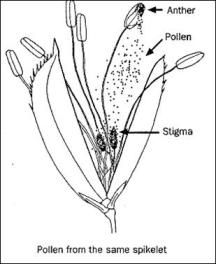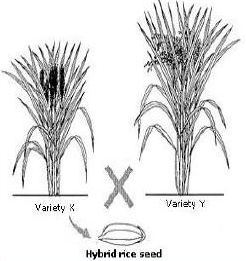|
Seed production for hybrid rice |
||
|
Introduction
To produce hybrid rice you need expert skills and strong knowledge of various practices to minimize costs and maximize returns.
To produce hybrids, you also need: 1. A national seed production and distribution system, 2. A national quality assurance program, and 3. National expertise to oversee production of lines and seed.
|
||
|
What is "inbred rice seed"?
|
||
|
How do you develop hybrid rice seed?
Hybrid rice seed is produced when the egg is fertilized by pollen from the anthers of a rice plant from a different variety or line. Hybrid rice seed is the first filial (F1) generation of a cross of two rice varieties that are genetically different.
|
||
|
Some extra requirements to produce hybrid seeds
Like any rice crop you need
But, fields for hybrid seed production have some more important requirements:
1. Flowering time Both parents need to flower at the same time. So, planting dates of the two parents will sometimes be different.
2. Supplemental pollination To help the spread of pollen ropes or sticks are often used to improve the spread of pollen from the male to the female line.
Using a rope to increase the spread of pollen in hybrid seed production fields.
3. Giberellic acid (GA) application GA increases the emergence of the female panicles from the sheath – improving the ability of the female to accept pollen form the male.
4. Isolation of seed production plots to protect genetic purity What we mean by protecting genetic purity is that the seed parent (or A line) is only pollinated by the male parent chosen as the B line or the R line. If pollen from different rice cultivars are close to the seed production plots, they can contaminate the seed parent and lower the quality of the hybrid seed.
Seed production crops should be isolated from other inbred rice crops in 3 ways:
A. Rice pollen can be carried up to 100 meters in air, so no other rice crop should be grown within 100 meters of hybrid seed production plots.
B. Change planting time to have different flowering times between the seed parent and other rice cultivars by at least 3 weeks.
C. Any natural, artificial, or crop barrier over 2.5 m high can prevent contamination. Sesbania, rostrata or a healthy, tall crop of maize, sorghum, or pearl millet make a good barrier.
|
||
|
More information needed?
To get a manual that describes and illustrates the many steps involved in hybrid rice seed production for both beginning and experienced seed growers, please visit http://www.knowledgebank.irri.org/hybridriceseed
The authors have presented a complex topic in systematic, easy-to-understand terms that should appeal to trainers and growers alike. |





